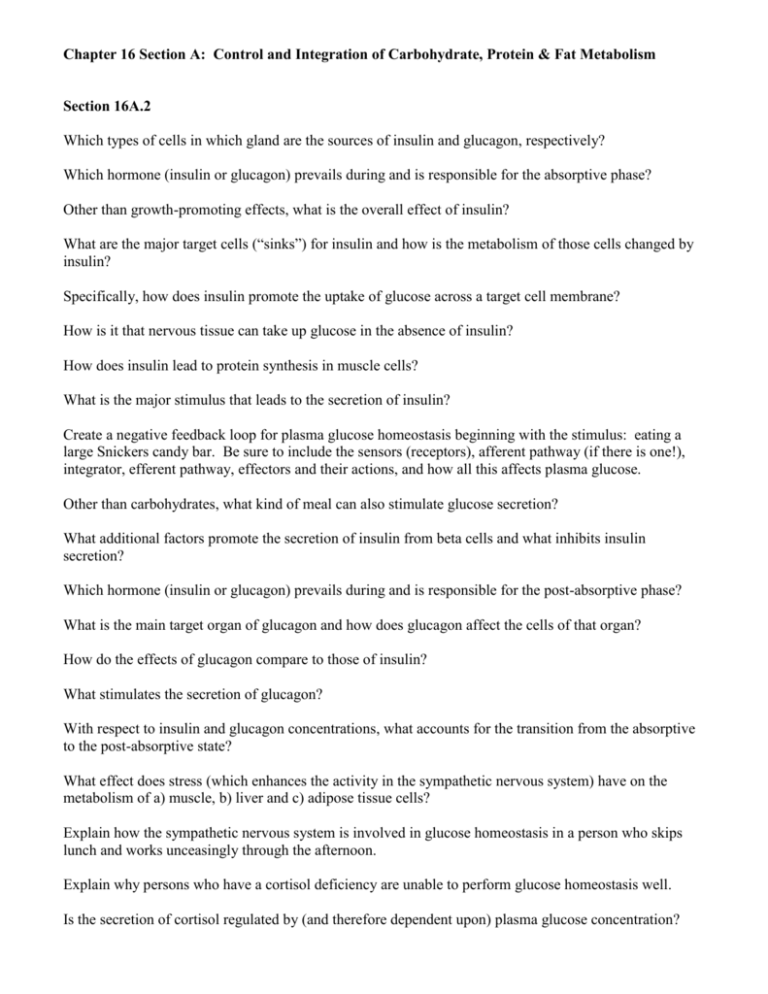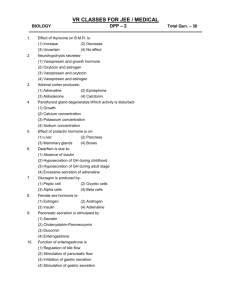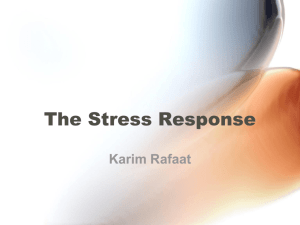Chapter 16 Section A: Control and Integration of
advertisement

Chapter 16 Section A: Control and Integration of Carbohydrate, Protein & Fat Metabolism Section 16A.2 Which types of cells in which gland are the sources of insulin and glucagon, respectively? Which hormone (insulin or glucagon) prevails during and is responsible for the absorptive phase? Other than growth-promoting effects, what is the overall effect of insulin? What are the major target cells (“sinks”) for insulin and how is the metabolism of those cells changed by insulin? Specifically, how does insulin promote the uptake of glucose across a target cell membrane? How is it that nervous tissue can take up glucose in the absence of insulin? How does insulin lead to protein synthesis in muscle cells? What is the major stimulus that leads to the secretion of insulin? Create a negative feedback loop for plasma glucose homeostasis beginning with the stimulus: eating a large Snickers candy bar. Be sure to include the sensors (receptors), afferent pathway (if there is one!), integrator, efferent pathway, effectors and their actions, and how all this affects plasma glucose. Other than carbohydrates, what kind of meal can also stimulate glucose secretion? What additional factors promote the secretion of insulin from beta cells and what inhibits insulin secretion? Which hormone (insulin or glucagon) prevails during and is responsible for the post-absorptive phase? What is the main target organ of glucagon and how does glucagon affect the cells of that organ? How do the effects of glucagon compare to those of insulin? What stimulates the secretion of glucagon? With respect to insulin and glucagon concentrations, what accounts for the transition from the absorptive to the post-absorptive state? What effect does stress (which enhances the activity in the sympathetic nervous system) have on the metabolism of a) muscle, b) liver and c) adipose tissue cells? Explain how the sympathetic nervous system is involved in glucose homeostasis in a person who skips lunch and works unceasingly through the afternoon. Explain why persons who have a cortisol deficiency are unable to perform glucose homeostasis well. Is the secretion of cortisol regulated by (and therefore dependent upon) plasma glucose concentration? What can make cortisol levels increase and what affect does this additional cortisol have on glucose metabolism? Up to a point, how can this be beneficial? In what ways are the actions of growth hormone similar to that of cortisol and opposite that of insulin? Create a list of the factors that are classified as glucose “counter-regulatory” controls. Which symptoms of fasting hypoglycemia are produced by stimulation of the sympathetic nervous system? Which symptoms of fasting hypoglycemia are the results of inadequate glucose delivery to the brain? What hormones are elevated during prolonged exercise? In what ways does sympathetic activity alter liver and muscle metabolism during exercise? In what ways does sympathetic activity affect the secretion of insulin and glucagon during exercise? How is it that skeletal muscles take up more glucose during exercise even though insulin levels are low and glucagon is high? How might the secretion of insulin be increased even before you eat a candy bar? (You probably won’t find the answer to this directly in the text, but consider what you know about mechanisms that other than negative feedback which could contribute to this pre-emptive response.)







